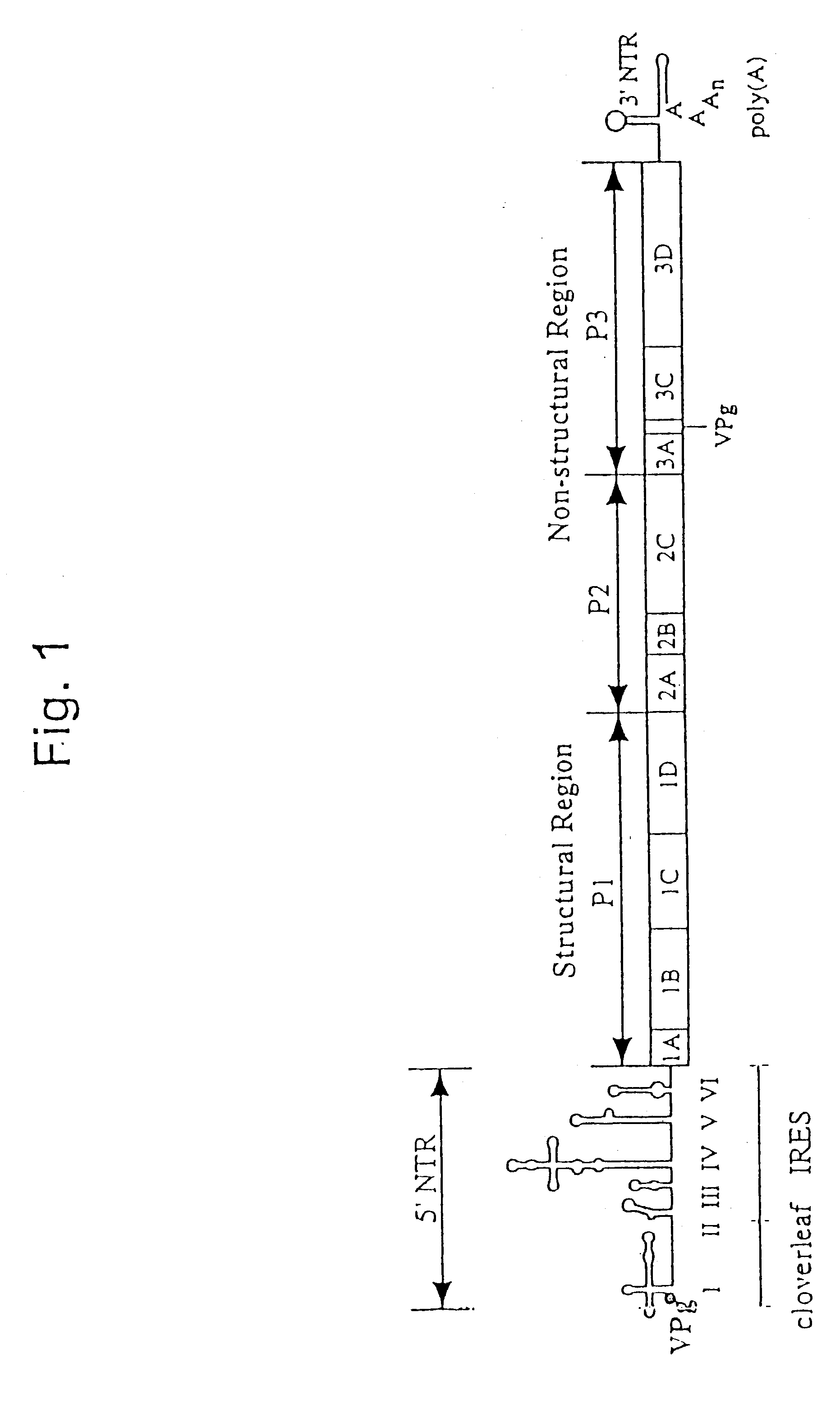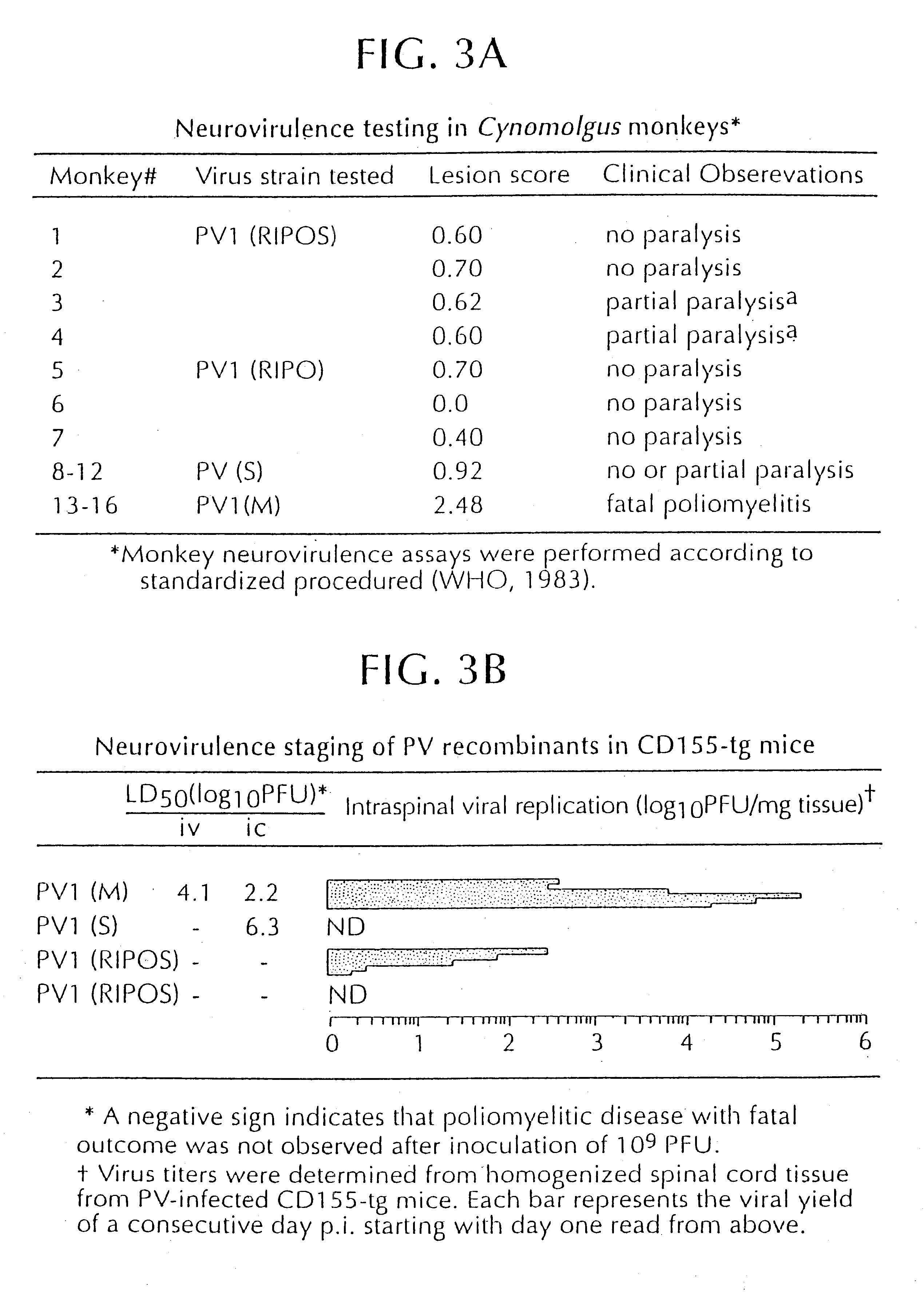Recombinant poliovirus for the treatment of cancer
a cancer and poliovirus technology, applied in the direction of biocide, drug composition, genetic material ingredients, etc., can solve the problems of many problems, serious adverse side effects of known and practiced methods, brain tumors, especially glioblastomas, and remain one of the most difficult therapeutic challenges
- Summary
- Abstract
- Description
- Claims
- Application Information
AI Technical Summary
Benefits of technology
Problems solved by technology
Method used
Image
Examples
example 2
In Vitro Growth of PV Recombinants in Cultured Cells to Determine Neurovirulence
Neurovirulence is tested in vitro and in vivo. For in vitro testing, cell lines HEp-2, derived from a human laryngeal epidermoid carcinoma, and SK-N-MC, derived from a neuroblastoma in a human subject, were obtained from ATCC and grown in Dulbecco's minimal essential medium (DMEM; GIBCO). 10% fetal bovine serum (GIBCO), penicillin (100 units / mL) and streptomycin (100 .mu.g / mL). HEp-2 and SK-N-MC, and monolayers in 6 cm. plastic culture dishes were inoculated with a suspension of PV1(RIPO) or PV1(RIPOS) at a multiplicity of infection of 10 and gently shaken for 30 min. at room temperature. Afterwards, the dishes were washed five times each with 5 mL of DMEM. Then the monolayers were overlaid with 2 mL of DMEM containing 2% fetal bovine serum. Synchronized infection was interrupted at the indicated intervals, cell monolayers were lysed by four consecutive freeze-thaw cycles, and the viral yield in the cell...
example 3
Determination of Neurovirulence in CD155-tg Mice and Cynomolgus Monkeys
All PV strains containing either the homologous or the heterologous IRES elements were assayed to determine their neurovirulent potential in mice transgenic for the human PV receptor, CD155-tg mice strain ICR.PVR.tgI, Koike et al., supra. Wild type (wt) PV strains induce in these animals a neurological disease indistinguishable, clinically and histologically, from primate poliomyelitis. CD155-tg mice were infected either by the i.c. or i.v. route and the clinical course of ensuing neurological disease was monitored. Animal central nervous system tissues were analyzed histopathologically and assayed for viral replication.
Groups of four mice were infected with a given amount of virus ranging from 10.sup.2 to 10.sup.4 pfu i.c. and 10.sup.3 to 10.sup.5 pfu i.v. for PV1(M) and PV1(R2-4); 10.sup.5 to 10.sup.8 i.v. and 10.sup.7 to 10.sup.9 i.c. for PV1(S), PV1(RIPO), PV1(RIPOS), PV1(R2-5), PV1(R6), PV1(R2-4,6), PV1(R5)....
example 4
Determination of Oncolysis with PV Chimeras
PV1(RIPO) was constructed by exchanging the cognate PV IRES with that of HRV2 (See FIG. 5). PV1(RIPO) is exceptional because of its loss of pathogenicity in CD155-tg mice, which develop poliomyelitis upon poliovirus infection, Ren, et al., supra; Koike et al., supra; Gromeier et al., supra) and in non-human primates (Cynomolgus monkeys) after intraspinal inoculation (FIG. 3).
Loss of neuropathogenicity of PV1(RIPO) was also evident by poor propagation in cultured cell lines of neuronal derivation, a phenomenon that correlates with cell-internal restriction of replication (FIG. 4). In contrast, propagation of PV1(RIPO) in rapidly dividing malignant cells, such as HTB-14 or HTB-15 glioblastoma cells (FIG. 9) or in HeLa cells (FIG. 8) was near wild type levels. The locus of attenuation of PV1(RIPO) was mapped to two stem-loop domains within the HRV2 IRES. See FIG. 5, which depicts PV variants with PV / HRV2 chimeric IRESes where HRV2 IRES compone...
PUM
| Property | Measurement | Unit |
|---|---|---|
| size | aaaaa | aaaaa |
| pH | aaaaa | aaaaa |
| concentration | aaaaa | aaaaa |
Abstract
Description
Claims
Application Information
 Login to View More
Login to View More - R&D
- Intellectual Property
- Life Sciences
- Materials
- Tech Scout
- Unparalleled Data Quality
- Higher Quality Content
- 60% Fewer Hallucinations
Browse by: Latest US Patents, China's latest patents, Technical Efficacy Thesaurus, Application Domain, Technology Topic, Popular Technical Reports.
© 2025 PatSnap. All rights reserved.Legal|Privacy policy|Modern Slavery Act Transparency Statement|Sitemap|About US| Contact US: help@patsnap.com



